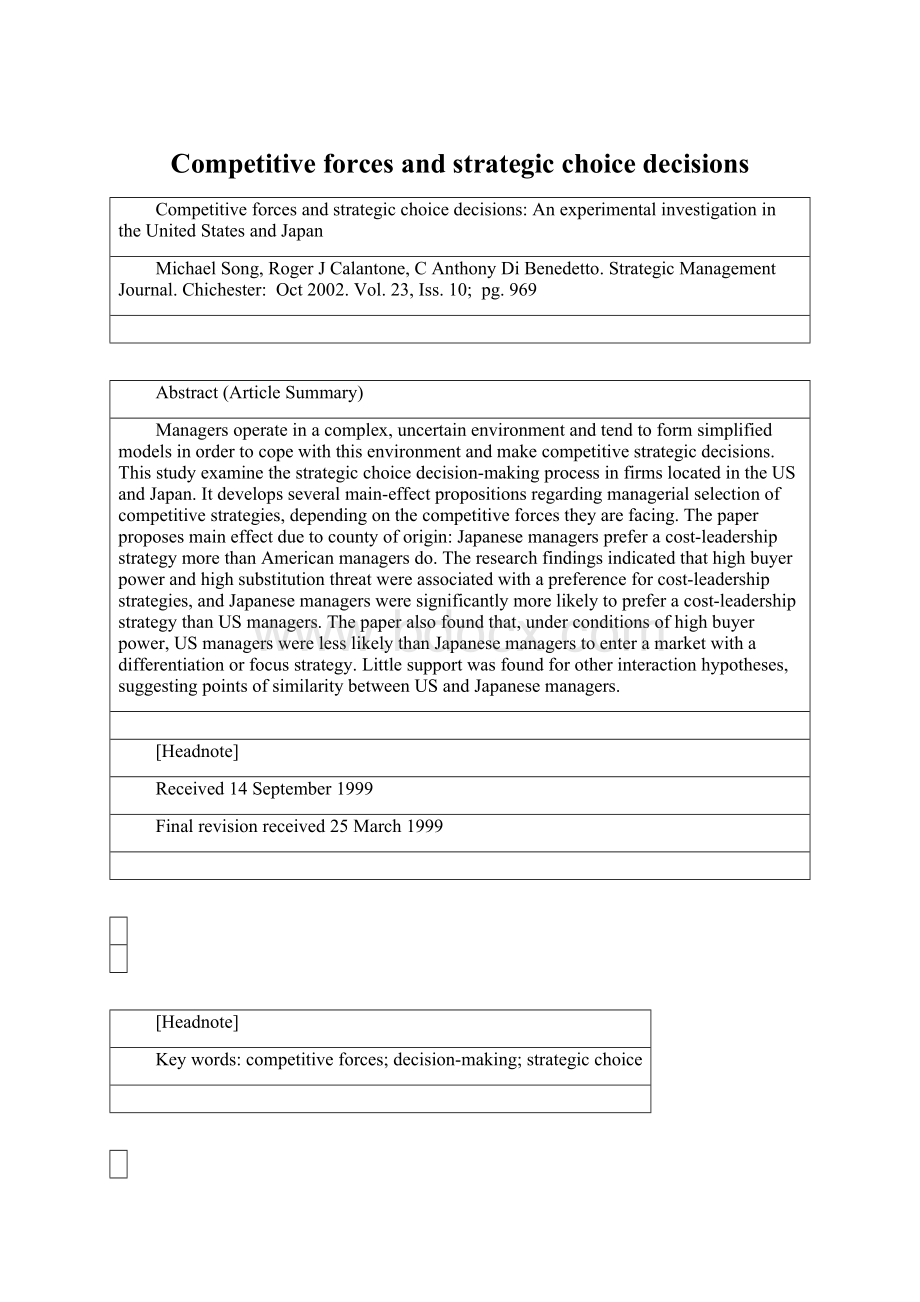 Competitive forces and strategic choice decisionsWord文档下载推荐.docx
Competitive forces and strategic choice decisionsWord文档下载推荐.docx
- 文档编号:18890858
- 上传时间:2023-01-02
- 格式:DOCX
- 页数:14
- 大小:28.03KB
Competitive forces and strategic choice decisionsWord文档下载推荐.docx
《Competitive forces and strategic choice decisionsWord文档下载推荐.docx》由会员分享,可在线阅读,更多相关《Competitive forces and strategic choice decisionsWord文档下载推荐.docx(14页珍藏版)》请在冰豆网上搜索。

StrategicManagementJournal.
Chichester:
Oct2002.
Vol.
23,
Iss.
10;
pg.
969
Abstract(ArticleSummary)
Managersoperateinacomplex,uncertainenvironmentandtendtoformsimplifiedmodelsinordertocopewiththisenvironmentandmakecompetitivestrategicdecisions.Thisstudyexaminethestrategicchoicedecision-makingprocessinfirmslocatedintheUSandJapan.Itdevelopsseveralmain-effectpropositionsregardingmanagerialselectionofcompetitivestrategies,dependingonthecompetitiveforcestheyarefacing.Thepaperproposesmaineffectduetocountyoforigin:
Japanesemanagerspreferacost-leadershipstrategymorethanAmericanmanagersdo.Theresearchfindingsindicatedthathighbuyerpowerandhighsubstitutionthreatwereassociatedwithapreferenceforcost-leadershipstrategies,andJapanesemanagersweresignificantlymorelikelytopreferacost-leadershipstrategythanUSmanagers.Thepaperalsofoundthat,underconditionsofhighbuyerpower,USmanagerswerelesslikelythanJapanesemanagerstoenteramarketwithadifferentiationorfocusstrategy.Littlesupportwasfoundforotherinteractionhypotheses,suggestingpointsofsimilaritybetweenUSandJapanesemanagers.
[Headnote]
Received14September1999
Finalrevisionreceived25March1999
Keywords:
competitiveforces;
decision-making;
strategicchoice
Managersoperateinacomplex,uncertainenvironmentandtendtoformsimplifiedmodelsinordertocopewiththisenvironmentandmakecompetitivestrategicdecisions(i.e.,costleadership,differentiation,orfocus).Inthisstudy,weuseanexperimentaldesigntoexaminethestrategicchoicedecision-makingprocessinfirmslocatedintheUnitedStatesandJapan.Wedevelopseveralmain-effectpropositionsregardingmanagerialselectionofcompetitivestrategies,dependingonthecompetitiveforces(buyerpower,threatofsubstitutes,threatofnewfirmentry,andhighintensityofrivalry)theyarefacing.Weproposeamaineffectduetocountryoforigin:
Japanesemanagerspreferacost-leadershipstrategymorethanAmericanmanagersdo.Wealsoproposeseveralinteractioneffectsregardingcross-nationaldifferencesinstrategyselectionbetweenJapaneseandU.S.managers.Totestourpropositions,wecollectedexperimentaldatafrom316U.S.executivesand459Japaneseexecutives.Weassessedrelativeimpactsofthecompetitiveforcesonstrategicdecision-makingusingamultilevelregressionanalysis.Theresearchfindingsindicatedthathighbuyerpowerandhighsubstitutionthreatwereassociatedwithapreferenceforcost-leadershipstrategies,andJapanesemanagersweresignificantlymorelikelytopreferacost-leadershipstrategythanU.S.managers.Wealsofoundthat,underconditionsofhighbuyerpower,U.S.managerswerelesslikelythanJapanesemanagerstoenteramarketwithadifferentiationorfocusstrategy.Wefoundlittlesupportforotherinteractionhypotheses,suggestingpointsofsimilaritybetweenU.S.andJapanesemanagers.Weconcludewithadiscussionoftheoreticalandmanagerialimplicationsofourresults.Copyright(c)2002JohnWiley&
Sons,Ltd.
INTRODUCTION
Managersuse'
mentalmodels'
tosimplifyandunderstandthecompetitiveenvironmentwithinwhichtheywork(PoracandThomas,1990;
Song,DiBenedetto,andZhao,1999).Intoday'
sglobaleconomy,strategicdecisions,suchasachoiceofcompetitivestrategyformarketentry,maybemorecomplexsinceculturaltraitsinfluencemanagerialperceptionsandactions(Ralstonetal.,1993;
Smith,Peterson,andWang,1996;
Hittetal.,1997).Managersfromdifferentnationsmayusedifferentcriteriatoselectacompetitivestrategy,becausetheyusedifferent'
mentalmodels.'
Thatis,managerswillbemostawareoftheforcesthattheyexperienceintheirhomecountry,andmaybelessawareofforcesthatareblockedbyinstitutionalfactors.Theywill,therefore,placedifferentlevelsofimportanceonthecompetitiveforceswhenassessingtheenvironment,andmayconsequentlyviewagivenmarketopportunityasmoreorlessattractive.Veryfewstudieshaveexaminedtheentrystrategydecisionacrosscultures.
Inthisstudy,weseektodeterminehowmanagersfromboththeUnitedStatesandJapanmakestrategydecisionsgivendifferentcharacteristicsinthecompetitiveenvironment,whichwecharacterizeusingPorter'
s(1980)fivecompetitiveforcesmodel.Ourfocusisondecisionprocess,i.e.,howmanagersmakethesedecisionsandwhichcompetitivemarketforcestheyconsidermostimportant(seediscussioninBouldingetal.,1994).Wedevelopseveralmain-effectpropositionsrelatingthecompetitiveforceswithselectionofcompetitivestrategy(i.e.,costleadership,differentiation,orfocusstrategy).Wealsodevelopseveralpropositionsconcerningexpectedcrossnationaldifferencesindecision-making.Oneoftheseisamaineffect:
Japanesemanagerswillpreferacost-leadershipstrategy,whileU.S.managerswillprefertheothercompetitivestrategies.Toinvestigatefurtherthecross-nationaldifferences,wedevelopotherpropositionsthattesttheinteractionbetweenindividualcompetitiveforcesandcountryoforigin.
Totestourpropositions,wegatheredasampleof316U.S.and459Japanesemanagers.Wepresented16differentscenariosofcompetitivestructuretomembersofthesample,andelicitedtheirlikelihoodofimplementingdifferentcompetitivestrategies.Wecalculaterelativeimpactsofthecompetitiveforcesineachdecisionbasedonindividualmanagers'
responsestothescenariospresented,andidentifysignificantmaineffectsandcross-nationaldifferencesintheseimpactsusingamultilevelregressionanalysis.
THEORYANDRESEARCHPROPOSITIONS
Managersmustdecide,earlyon,whichstrategicoptiontousewhenenteringanewmarket.Muchempiricalresearchofmanagerialdecisionmaking,suchasthestudiesderivedfromthePIMSdatabase(e.g.,Robinson,Fornell,andSullivan,1992;
HuffandRobinson,1994)suggeststhatthestrategicdecisionsmadebymanagershavesubstantialimpactonlong-termfirmperformance.
Inordertomakesenseofthiscomplexenvironmentsurroundingthem,managerstendtoformsimplifiedinternalcognitiverepresentations(AlbaandHasher,1983;
HillandLevenhagen,1995).Theserepresentationsaretheresultofinteractingwithand'
experiencing'
theenvironment.Usingtheirexperiencewithandunderstandingoftheenvironment,managersfocusoncertainpiecesofinformationthattheyjudgetobecritical,andmakedecisionsandmeasuretheirperformancebasedonthisinformation(PoracandThomas,1990).
ThePorterfiveforcesmodel(Porter,1980,1985)isfrequentlyusedinthemanagementliteraturetoassessthecompetitiveenvironment(e.g.,BouldingandStaelin,1993).Thebasiccompetitiveforcescomprisingthemodelaretherivalrybetweenexistingcompetitors,thethreatofnewentrants,thethreatofsubstituteproducts,thebargainingpowerofsuppliers,andthebargainingpowerofbuyers.Theobjectiveinsettingcompetitivestrategyistoseekapositioninwhichthesefiveforcesdothefirmthemostgoodorcauseittheleastharm(Porter,1980).Toovercomethesecompetitiveforcesandsucceedinthelongterm,managementcanselectfromseveralcompetitivestrategies:
costleadership,differentiation,orfocus.Thesearenotmutuallyexclusive,asfirmscancombinestrategies(e.g.,differentiatorscanusecostleadershipstrategies).
Weexpectthateachofthecompetitiveforceswillaffectthelikelihoodsofselectingfromamongthecompetitivestrategies.First,highlevelsofbuyerpowerwilllimitafirm'
sabilitytochargehigherprices,asmorepowerfulbuyerswillbeabletodemandpriceconcessionsfromtheirsuppliers(SchererandRoss,1990).Thusthefirmmustseektoreducecostsinordertoearnabove-averageprofitsifbuyerpowerishigh.Secondly,ahighthreatofsubstitutionimpliesthatanalternativeproducttypeoffersapriceorperformancebenefitandlimitsindustryprofitability.Thefirmcanearnsatisfactoryprofitswhileundercuttinganypotentialcompetitoronpricebypursuingacost-leadershipstrategy.Thus,byreducingthealternativeproducttype'
spriceadvantage,thefirmprotectsitselffromattackinthelongterm(SchererandRoss,1990;
Porter,1980).
Thethreatofentrybynewfirmsishighestduringthehighgrowthphaseoftheproductlifecycle,asdemandincreases,newmarketsegmentsemerge,andnewentrantsstakeaclaimintheemergingmarket.Atthispoint,thecompetitivefocusshiftsfromprimarytoselectivedemand,andfirms(includingtheincumbent)differentiatetheirproductsonattributesdeemedimportantbycertaincustomersegments(UtterbackandAbernathy,1975;
Mansfield,1986,1993).Finally,competitiveintensityislikelytobehighestduringmaturity/latematuritystagesoftheproductlifecycle,ascompetitionforselectivedemandintensifiesandincreasinglylargesumsarespentonincrementalproductinnovationsandcommunicationsprograms(Kotler,2000;
Robinson,1969).Duringthistimeofintensecompetition,firmswillseektodifferentiatetheirofferings,orfocusonprotected,profitableniches.Theseconsiderationsmaybeexpressedasaseriesofmaineffectpropositions:
Proposition1:
Managersaremorelikelytopreferacost-leadershipcompetitivestrategywhenfacingascenarioofhighbuyerpower,otherthingsbeingequal.
Proposition2:
Managersaremorelikelytopreferacost-leadershipcompetitivestrategywhenfacingascenarioof
- 配套讲稿:
如PPT文件的首页显示word图标,表示该PPT已包含配套word讲稿。双击word图标可打开word文档。
- 特殊限制:
部分文档作品中含有的国旗、国徽等图片,仅作为作品整体效果示例展示,禁止商用。设计者仅对作品中独创性部分享有著作权。
- 关 键 词:
- Competitive forces and strategic choice decisions
 冰豆网所有资源均是用户自行上传分享,仅供网友学习交流,未经上传用户书面授权,请勿作他用。
冰豆网所有资源均是用户自行上传分享,仅供网友学习交流,未经上传用户书面授权,请勿作他用。
链接地址:https://www.bdocx.com/doc/18890858.html


 铝散热器项目年度预算报告.docx
铝散热器项目年度预算报告.docx
